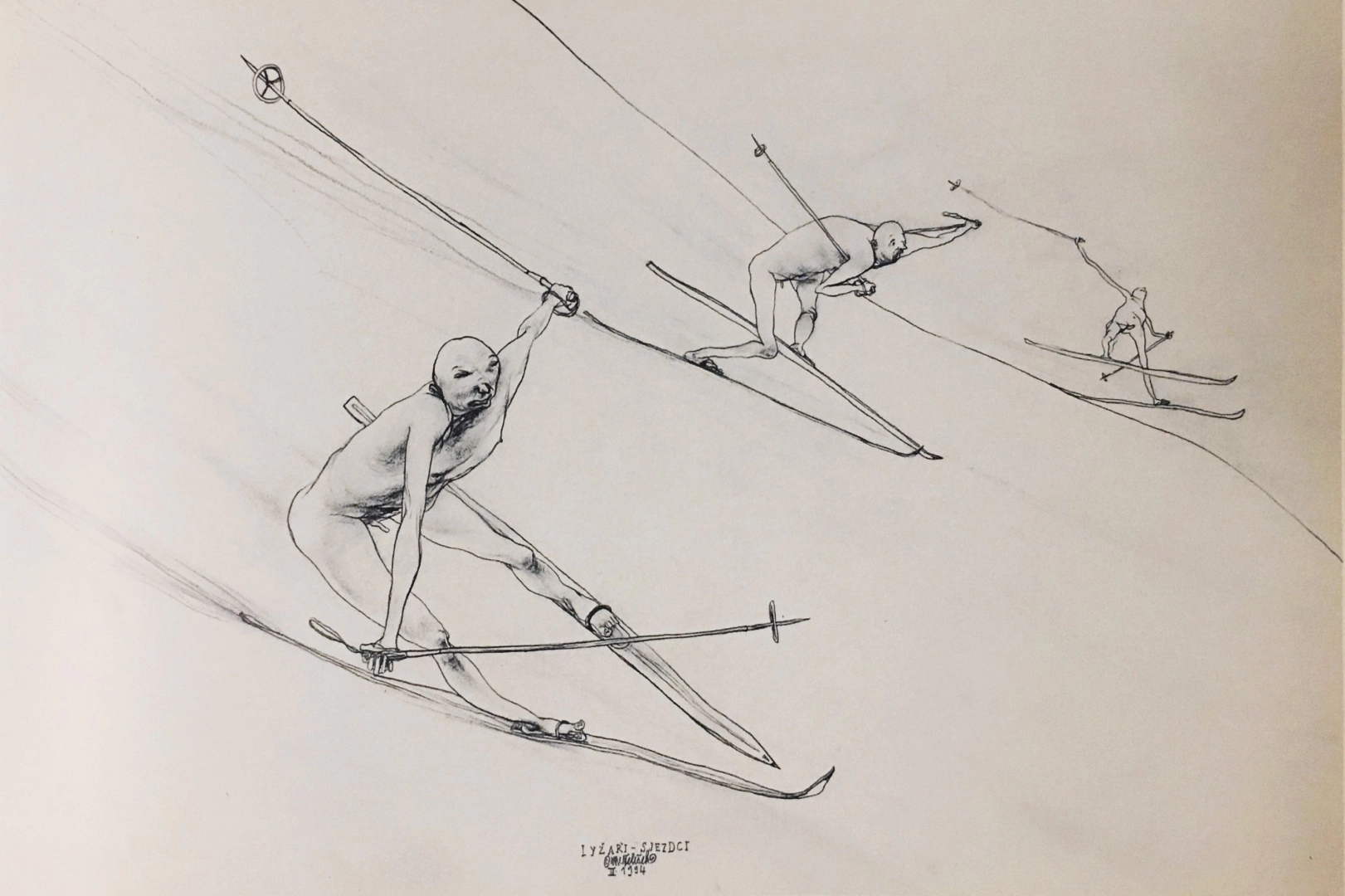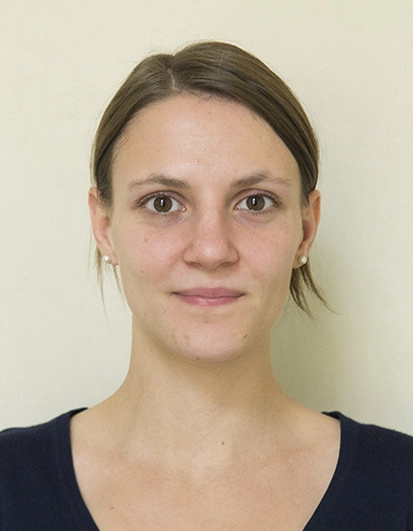Although the artist's famous cycle really focuses on skiers, don't expect athletic figures or brand-name sports equipment in his drawings. Martin Velíšek's skiers completely surpass traditional concepts. Deformed, naked guys with rickety figures, bulging bellies and flaccid limbs, who one associates with the sport only because of the skis attached to their feet, certainly do not approach the concept of kalokagathia. However, grotesque, dark humor and the little unseemly skiers are inherent to punker Martin Velíšek, one of the founders and creators of the legendary pub U Vystřelenýho Oka (The Shot-Out Eye).
.jpg)
Martin Velíšek's Skiers, a set of drawings published in 1996 by Argo books, is not limited to just one winter discipline. In the individual drawings one recognizes cross-country skiers, ski jumpers and downhill racers. His skiers, nonetheless, find themselves in a variety of unlikely situations and burdened by limiting circumstances such as blindness, dumbness, or drunkenness, they aren't much prepared to encounter snow and mountains.
Yet they won't take the skis off under any circumstances. Not even when the author places them in the middle of a pool to literally draw a parallel to the pool jumping platform, or when they just rest at home in their beds. The motifs of sunbathing skiers, skiers accompanied by sledders, or a snowman are perhaps the only ones which at least seemingly meet the classic winter themes. Humor is also the main ingredient in the depiction of the common ski culture rituals – waxing skis, snack being one tiny pear, or certain sporting rivalry, the bizarreness of which reflects in the piece Lyžaři – kdo má lepší lyži (Skiers – Who Has a Better Ski)?

Nudity is one of the basic features of Velíšek's characters. Skiers with Their Friend Frozen to Death seem to be the only ones dressed, perhaps because the artist wants to evoke that the cold has reached a life-threatening degree. Also one of the skiers from the pool scene has a towel wrapped around him, but the only accessories the other participants wear, apart from their skis, are just their swimming goggles. For Velíšek drawings are typical for their often harsh and brutal scenes; from already mentioned Skiers with Their Friend Frozen to Death to funerals or fights, in which skis get broken, eyes poked out with a ski pole, skiers get stabbed with a ski or impaled by a pole.
It seems that the whole cycle doesn't have much to do with skiing after all, which the author himself somewhat confirms:
"When the newspapers ran stories about my Skiers, they came up with the strangest claims – such as that I take an interest in existential sports. Nonsense. This book is not about sports. Skis were created for people to move around more efficiently. The fact that some guys later began to measure the time it takes them to cover certain distances is something else. It always turns out like this in our civilization. Somebody invents something and rest – in the better case – use it and in the worst case abuse it. I'm just playing around.“
.jpg)
Martin Velíšek is a drawer. Although illustration and drawing essentially produce small-format pieces, he is still attracted to large-scale works. His drawings are minimalistic, with precisely captured details. He chose pencil and paper as well for his skiing cycle and rather than shrink away from the white space, he used it as an asset. White paper suggests endless snow plains, fog and snowy landscapes.
As a figurative artist, he is interested in humans set in the surrounding environment. The way he draws his characters is permeated with fragility, which gives aways his glass-making background. The counterpart to that are their long, grimaced faces, deformed and imbued with a kind of ruggedness. All his skiers are men, because, as he himself says, they're easier to draw:
"Caricaturing women is hard. So that it doesn't unnecessarily offend them, so that it doesn't humiliate them. I don't want to insult anybody, rather I want to caricature their actions and deeds rather than the people themselves. But now I'm after the ladies again. I missed them gals."
.jpg)
He fancies being labeled as an artist of the Czech grotesque, which peaked in the 1970s and which is represented by names such as Michael Rittstein, Karel Nepraš, Jiří Sopko or Jiří Nácheradský. After all, its essential elements – exaggeration, banality or absurdity form the foundation of his work. Yet, for his own sake, he created his own style which he named Academic Civilianist Pseudorealism. It's supposed to refer to the distorted reality and the peculiar style of his works.
.jpg)
In 1997, Velíšek's Skiers gave rise to a theatre performance. Bílé Divadlo Ostrava (White Theater Ostrava), which translated the drawings into a scenic form, gained recognition with their play titled Ty, který lyžuješ (You who ski) abroad, at festivals in France, Germany and Poland, and they also opened the Velíšek's exhibition Skiers in Stockholm. Even the author himself approves of the theatrical form.
"Nothing but naked fat guys on ancient skis! They did an awfully great job with that. At first I was a little worried about how they were going to perform that, but they really surprised me. It has an immense aesthetic, those guys really took it charge of that and did it with all due diligence. Even if they're naked, there's nothing vulgar or offensive about it. Once I had an exhibition of Skiers in Pilsen and they set out on the skis naked from the gallery to the square, to the Church of St. Bartholomew. People on the tram almost fell out of the windows, grannies were dropping their shopping bags. What a blast!"

The response to the cycle Skiers came also form his namesake, painter Martin Velíšek "Junior", who, in an effort to combat the unavoidable misunderstandings due to the same name and craft, created a drawing cycle Bruslařky (Skaters) as a kind of reference to the Skiers.
"I thought I'd do the Skaters cycle – and if Martin's has naked skiers, mine will have naked skaters. I thought it would be funny and it would work, but the Internet now says that Martin shifted his focus from skiers to skaters. So that didn't help at all,“ comments the younger artist on his failed attempt to escape the shadow of his older colleague.
Although Martin Velíšek himself is not an athlete, his other artistic achievements in the sports field, in addition to Skiers, is worth mentioning as well. In 2015 he created a poster for the Chess festival and a year later he created a chess tournament poster for the Prague Chess Society.

Martin Velíšek was born on 21 October 1963 in Duchcov. He wanted to become an archaeologist, but eventually graduated in glassmaking at the Secondary School of Glassmaking in Kamenický Šenov. He continued his education at Stanislav Libenský's glassmaking studio at the Academy of Arts, Architecture, and Design in Prague (UMPRUM) in Prague, from which he graduated in 1989. In 1992, he spent the summer teaching at the Pilchuk Glass School in the US. His glass vases and objects represented the Czech Republic at the exhibition World Expo in Japan in 2005.
He works as a drawer and illustrator. He was awarded the Czech Lion Film Award for the stage design of Jan Werich's film Fimfárum. The original book Skiers published by Argo in 1996 is one of the author's most beloved creations. He also created illustrations for Babička (Grandmother [an important Czech book]) and Orwell's Animal Farm. Unlike with the Skiers, though, he was struggling with the illustrations for Babička for a long time; according to him, it was one of his most difficult jobs. He is a member of an alternative band Už jsme doma (We're Home Now) whose visual style is his creation. He co-founded U Vystřelenýho Oka (The Shot-Out Eye) in Žižkov, which he decorated himself and where you can still run into him regularly.






